
Leaders
Refocus Lab to Face Coming Challenges
Portable High-Resolution
NMR Sensor Unveiled at Berkeley Lab
Leaders Refocus Lab to Face Coming Challenges
Berkeley Lab senior officials are reorganizing activities and repositioning resources to capitalize on new opportunities for new program development. In addition, the Lab-oratory is facing financial challenges that it has not seen in many years.
An ambitious Laboratory schedule of initiatives and capital projects will need to be nurtured amid continuing national pressures on science funding. Thus Berkeley Lab is looking at a future of changing missions marked by belt-tightening, priority-setting, and streamlining.
What that translates to in terms of long-term staffing and program support is largely unknown. In the short term, Lab Director Steve Chu has initiated a review of the indirect cost distribution structure — that is, how activities supported by Laboratory overhead are charged back to projects. Some actions, such as mid-year program reductions to overhead-funded programs, have already been initiated to reduce the G&A (General and Administrative) budget — not to reduce total Laboratory costs, but to distribute the funds more fairly. A reorganization of the Administra-tive Services Department (see Page 3) has also been announced.
The purpose of the Cost Distri-bution Committee review, set to begin soon, is “to make sure that research activities are charged fairly through the indirect structure,” Chu said. “We also want to ensure alignment between the Labora-tory’s mission and good business practices, to reduce compliance vulnerabilities, and to make the indirect cost structure as transparent and fair as possible.”
Berkeley Lab’s recent successes in its nanoscience, physical bioscience, and computing science research programs have driven the need for additional laboratory space on the Hill. The Molecular Foundry is now being constructed, and buildings for nanoscience, computing sciences, and user support at the Advanced Light Source are on the drawing board. These plans dovetail nicely with the Lab’s evolving strategy, outlined for the Department of Energy in the University of California’s contracting proposal, for project growth in research areas such as nanotechnology, systems biology, new energy alternatives, and advanced computing.
“If we’re going to be able to build new buildings for our scientific initiatives,” Chu said, “we will need to spend less and find real savings in all of the overhead areas; find where we can achieve economies, and what we can do without.” Chu added that investing in resources wisely now will allow the Lab to attract the people it needs to guarantee a healthy future.
The urgency to upgrade present facilities and to modernize the aging Berkeley Lab infrastructure is also reflected in the competition for high-priority expenditures.
Chu said that the Laboratory is working closely with the University of California on a funding plan that would feature favorable preferential interests rates for new building construction. If successful at exercising this option, the Lab would service loan debt largely from the overhead budget. Hence the need for maximum cost-effectiveness in providing services in all the overhead-funded areas, which include Facilities, Human Resources, the Office of the Chief Financial Officer, Business and Administrative Services, Information Technologies and Services, Public Affairs, Work-force Diversity, the Legal and Patent Departments, Technology Transfer, and the Offices of the Director and Deputy Director.
On a parallel track with the excitement of program growth are the harsh realities of constrained budgets in Washington. A tenuous future for research funding was foretold in President Bush’s budget request for FY 2006 which, if approved, would reflect a tighter-than-average year. And the prospects for FY07 and FY08 are even more sobering. The FY06 federal proposal holds spending to a less-than-inflation 2.1 percent increase, with much of that going to the departments of Defense and Homeland Security. Other discretionary spending would be cut by an average of 1 percent, with most nondefense, nonsecurity federal agencies slated for flat or reduced funding.
Among those absorbing cuts is the Department of Energy’s Office of Science, scheduled for a 3.9 percent reduction. If enacted, that translates to a tighter budget for Berkeley Lab than it’s had in several years. After more than a decade of steep cuts and stagnant budgets, the Office of Science has less money now for its R&D programs than it did in the early 1990s. In today’s dollars, the science program has been stuck at roughly $3.1 billion since FY 2001, but the FY06 budget would represent a sharp downturn compared to the modest increases of the most recent years. The total federal research investment would fall 1.4 percent to $55.2 billion.
Federal program expenditures can be categorized as discretionary or nondiscretionary. Nondiscretionary spending is mandated by law, and includes programs such as Social Security. Unless the underlying law is changed, as is now being proposed for Social Security, spending is largely automatic. Discretionary spending varies, and depends on the will of the Congress as expressed through the appropriations bills. R&D funding falls into this category, so that the annual budgets for NSF, DOE and other science agencies will vary.
Large federal deficits and the continuing wars in Iraq and Afghanistan have resulted in a very tight budget environment. The Administration wants to cut the federal deficit — now estimated at $426 billion — in half by 2009. Toward this end, the Bush Admin-istration has proposed cutting the overall level of discretionary non-defense/homeland security spending by almost 1 percent in FY 2006. That proposed cut is a perspective through which to view the R&D budget request for FY06, as well as for FY07 and FY08.
And less money coming into the Lab means less money collected through G&A assessments to program budgets.
Also contributing to the stress on G&A funding is an anticipated increase in the management fee levied by the University, which includes rebuilding the so-called “risk fund” contributions that each national lab managed by UC must make in order to build up a reserve for offsetting unallowable costs and other unexpected liabilities.
Several divisions have already endured reductions in force over the past year. Although future RIFs cannot be predicted at this time, layoffs will remain an option during these tough fiscal times. Since G&A is allocated mostly to salaries, it is anticipated that some areas of Laboratory staff effort will be reduced. This is being addressed in the divisions of the Lab that are funded by G&A. More information will be communicated through staff meetings and special notices to departments and divisions impacted by these changes.
Portable High-Resolution NMR Sensor Unveiled at Berkeley Lab
Homeland security experts may soon be getting a valuable new tool for identifying the chemical constituents in suspicious substances. A portable device makes it possible for the first time ever to take high-resolution NMR spectroscopy — one of the principal tools for chemical analysis — out of the laboratory and into the field for use on samples of any size. This portable NMR sensor was developed by a collaboration of researchers from Berkeley Lab, UC Berkeley, and the Institute for Technical Chemistry and Macromolecular Chemistry in Aachen, Germany.
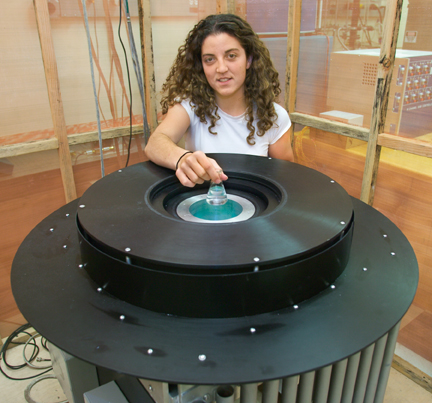 Vasiliki Demas loads a sample for analysis inside a low-field electromagnet
currently being used as a testbed for obtaining high-resolution NMR
spectra without having to place samples inside the bore of a high-field
magnet. Photo by Roy Kaltschmidt, CSO
Vasiliki Demas loads a sample for analysis inside a low-field electromagnet
currently being used as a testbed for obtaining high-resolution NMR
spectra without having to place samples inside the bore of a high-field
magnet. Photo by Roy Kaltschmidt, CSO
“Our device does not compete with the superconducting magnets that are used to study proteins, but there are many applications besides homeland security where you can’t bring samples from the field to the laboratory, including medical diagnosis, archaeological analysis, or the exploration of objects in space, like planets or moons,” said chemical-engineering graduate student Vasiliki Demas, one of the co-authors of a paper describing the portable NMR device, which appears in the April 8 issue of the journal Science. Demas is a member of the research groups of Jeffrey Reimer of the Environ-mental Energy Technologies Division, and Alexander Pines, a chemist with the Materials Sciences Division. Both scientists hold joint appointments with UC Berkeley’s chemistry department.
In addition to Reimer and Pines, other principal authors of the Science paper are Bernhard Blümich, Federico Casanova and Juan Perlo of the Aachen Institute, and Carlos Meriles, a physicist now at City College of New York.
NMR is a phenomenon involving the atomic nuclei of molecules in which at least one proton or neutron is unpaired. The imbalance causes such nuclei to spin on their axes like miniature tops, and gives rise to a magnetic moment, which means the nuclei act as if they were bar magnets with a north and south pole. When a sample is exposed to a strong external magnetic field, these spinning “bar magnets” attempt to align their axes along the lines of magnetic force. The alignment is not exact, resulting in a wobbly rotation about the force lines that is unique for each type of nucleus. If, while exposed to the magnetic field, the nuclei in a sample are also hit with a radiofrequency (rf) pulse, they will absorb and re-emit energy at specific frequencies according to their individual rates of rotation. These frequencies show up in an NMR spectrum as distinct peaks of varying height that, like a set of fingerprints, can be used to identify the sample’s constituent nuclei.
Because the rate at which resonating nuclei realign themselves with magnetic field lines is heavily influenced by their neighboring nuclei, NMR can also be used to provide detailed information on the structural, dynamic, and spatial relationships of atoms in a sample. Deviations from reference peaks on the NMR spectrum, called “chemical shifts,” reflect different concentrations of a sample’s constituent nuclei and can be used to positively identify the molecular composition and chemical nature of the sample.
Until recently, high-resolution NMR spectroscopy could only be done by placing a sample inside the bore of a large stationary magnet that produces a strong, uniform magnetic field. Portable NMR systems with open, single-sided probes have been built, but the lack of uniformity in their magnetic fields limits them to low resolution.
“The variations within the magnetic fields of previous portable NMR devices are usually orders of magnitude too large to detect chemical shifts,” said Demas. “These devices mainly yield relaxation times as a crude estimate of a sample’s composition.”
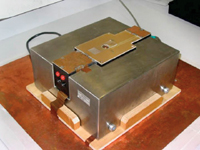 This
portable device utilizes a unique “ex-situ” NMR technology
to make it possible to obtain a high-resolution NMR spectrum outside
of the laboratory and from samples of any size.
This
portable device utilizes a unique “ex-situ” NMR technology
to make it possible to obtain a high-resolution NMR spectrum outside
of the laboratory and from samples of any size.
In 2001, an effort led by Pines, Meriles, and Dimitris Sakellariou, formerly with the UC Berkeley chemistry department, demonstrated a technique for obtaining high-resolution NMR spectroscopy data from samples in a grossly nonuniform magnetic field. In this “ex situ” method, the lack of uniformity in the magnetic field is compensated for by zapping a sample with a series of rf pulses that are precisely varied in energy, duration and timing.
The authors of the new Science paper applied the ex-situ technique in a portable single-sided sensor device, which for these experiments was configured for high-resolution NMR spectroscopy. Two concentric U-shaped permanent rare earth magnets (neodymium-iron-boron) were arranged to create a magnetic “sweet spot” about seven millimeters above the active magnet surface. In this sweet spot, the static magnetic field is parallel to the plane and reaches a field strength of 0.2 tesla.
The rf pulses were generated through a rectangular rf coil that is shaped and positioned with the inner of the rare earth magnets to optimize the interaction between the static magnetic field and the magnetic fields generated by the rf pulses. When a sample is placed in the sweet spot and hit with a carefully orchestrated series of rf pulses, the result is an NMR spectrum with a sharp enough resolution to reveal chemical shifts of eight parts per million within three minutes after sample testing begins.
“Eventually, we think we can attain better than one part per million resolution. That is our goal for when this device becomes commercially available,” said Demas.
Asteroid Bears Name of Starry-Eyed Couple
Todd Hansen was but eight years old when his father took him outside on a clear night to show him Mars and point out to him how our planetary neighbor moves across the sky. That first encounter with the magic of the starry night captured the youngster’s imagination for life. A few decades and thousands of astronomical observations later, he has a very special new space object to add to his list of astronomy favorites: Asteroid 30934, a.k.a. Baker-Hansen, recently named after Hansen, an analyst with the Lab’s Office of Planning and Strategic Development, and his wife, Lonny Baker.
“My wife and I were thrilled, like kids on a perfect Christmas,” he said of the news.
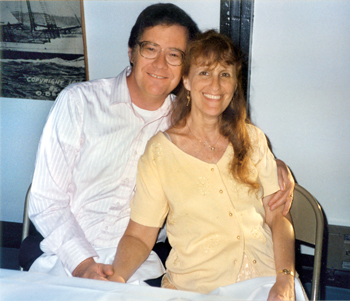 Berkeley Lab’s Todd Hansen and his wife, Lonny Baker, had an
asteroid named after them in recognition of their rich contributions
to astronomy.
Berkeley Lab’s Todd Hansen and his wife, Lonny Baker, had an
asteroid named after them in recognition of their rich contributions
to astronomy.
The naming of celestial objects is done by a subcommittee of the International Astronomical Union in recognition of individuals’ contributions to astronomy. Baker and Hansen were nominated by famed astronomers David Levy and Carolyn Shoemaker, codiscoverers of Shoemaker-Levy 9, the comet that collided with Jupiter in 1994, resulting in the most spectacular explosions ever witnessed in the solar system.
Baker’s contributions to the field are such that when Levy first suggested to Shoemaker that the couple be recognized by having a celestial object named after them, her reaction was, “Oh, Lonny doesn’t have one already?”
Baker’s involvement with astronomy goes back more than 30 years, from her days working on the Pioneer program, to decades of work in astronomy education, and more recently volunteer work for the Planetary Society. In 1979, during Pioneer 11 spacecraft’s first encounter with Saturn, Baker was working at Mission Control while data was coming down. There, Baker was the first person to pick up extra dots on both sides of the planet — observations of what the team would eventually announce as discovery of the F ring of Saturn.
Baker spent the next 16 years involved in astronomy education at planetariums in Tucson and San Francisco, working with hundreds of thousands of people and giving occasional TV interviews. She also worked for the Astronomical Society of the Pacific and now serves as global volunteer leader with the Planetary Society.
Although Hansen humbly claims that “I am far less important in the astronomical scheme of things” than his wife, he has compiled an impressive portfolio of his own after decades of extensive observations as an amateur astronomer, which he summarized in a book entitled Deep-Sky and Other Enthusiasms. His observations include the earliest systematic survey of quasars and BL Lacertae Objects (celestial objects that are powerful sources of rapidly-varying infrared, light and radio waves) visible with amateur-size telescopes.
While some question the feasibility of observing objects as faint as quasars with a 10-inch telescope, Hansen is confident of his observations, which he has carefully documented. He also notes that the astronomical feat can only be accomplished “under superb conditions” — on his parents’ ranch outside Ukiah, in his case.
“Celestial objects reach so far beyond ourselves,” Hansen says, explaining his fascination with astronomy. “Some objects we look at are a significant fraction of the universe away — billions of light years from here. Those photons left before Earth existed. It is totally inspiring. Astronomy always has that appeal.”
Hansen obtained his undergraduate degree in engineering and later went back for a masters in physics. His area of special interest is general relativity, which he said “is even more mind-boggling than astronomy.” That’s saying an awful lot for Hansen, who derives such great joy from hunching behind a telescope, staring into the night.
“We look at fuzzy little spots of light,” he smiles. “To most people they may not be as visually compelling as, say, watching lively, colorful birds. But add to that the knowledge of what these objects really represent and the human endeavor to get to that knowledge, and the experience becomes one of the richest of my life.”
Fifth Graders in Lab Program Enjoy Mayoral Visit
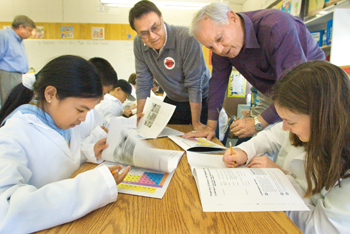
Berkeley Mayor Tom Bates (second from the right) helps fifth-grade students at Washington Elementary School in Berkeley with their workbook answers as Rollie Otto, head of Berkeley Lab's Center for Science and Engineering Education (CSEE) watches on. The Mayor visited the school on Tuesday while Dale Koistinen (background, left), also of CSEE, taught a class as part of a Lab program to help prepare the district's fifth graders for the science portion of the upcoming Standardized Testing and Reporting (STAR) tests, administered by the State of California. Photo by Roy Kaltschmidt, CSO
Work Together to Avoid Injuries
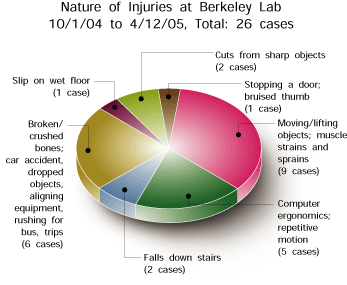
Recently, two Berkeley Lab employees manually lifted a 160-pound piece of equipment onto a scale. A few hours later, one of the employees experienced back pain which he attributed to the heavy lifting. A back injury from overexertion can cause lasting pain and discomfort. “Because we care about each other, we need to understand how to avoid these injuries and watch out for our co-workers,” says Phyllis Pei, director of the Environ-ment, Health, and Safety (EH&S) Division. A subsequent evaluation found that nearby lifting aids were not used, that both employees felt they needed to rush to complete the task quickly, and that they weren’t given enough prior notice to adequately prepare for and schedule the job. This article highlights several ways we can learn from recent injuries and avoid future incidents. Discuss these in group meetings and take these lessons to heart.
Unfortunately, although the injury was entirely preventable (the employees believed they could have prevented it by planning the task beforehand and thoroughly assessing the hazards beforehand), this is not an isolated case. Over the past 10 years, Berkeley Lab has worked hard to reduce its injury rates. Last year, the Lab’s injury rates were among the lowest of the 10 DOE Office of Science labs. But since January, Berkeley Lab’s injury rates have shown a steady and troubling increase. In 2004, there was an average of three recordable injuries per month. Over the past three months, however, the injury rate has jumped to approximately five per month.
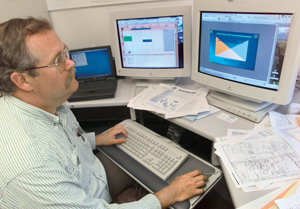 People who spend long hours in front of a computer, such as Terry
Hazen (above), should take frequent breaks to avoid injury. Photo
by Roy Kaltschmidt, CSO
People who spend long hours in front of a computer, such as Terry
Hazen (above), should take frequent breaks to avoid injury. Photo
by Roy Kaltschmidt, CSO
This recent rise in injuries is attributable to several main categories: improper lifting and moving objects, repetitive stress from improper computer use or workstation set-up, electric shocks, and falling down stairs or slipping in a puddle of water. Often, rushing to complete a task leads to an injury. For example, an employee was struck by a car while hurrying to catch an onsite bus. A review of these incidents reveals that they could have been avoided, which is why Lab Director Steve Chu has asked all employees to redouble their efforts to work safely.
Berkeley Lab has a strong safety culture, but it could be stronger if everyone adhered to a few simple guidelines. In most cases, vigilance and common sense can stop accidents before they occur. This means slowing down, observing one’s surroundings, carefully planning tasks before doing them, and if a job appears unsafe — not doing it, no matter how much pressure there is to finish the task. Paying close attention to fellow employees is another critical way to curb the injury rate. Because many injuries occur in the presence of others, it is imperative that people warn or stop fellow employees who are working unsafely. Safety is everyone’s responsibility.
All injuries must be reported, no matter how small. This ensures that proper medical care is received, and can help prevent future accidents. In addition, the EH&S Division’s website, www.lbl.gov/ehs/, has a link for suggestions on ways to improve safety at the Lab. Comments can be submitted anonymously via an online form or, if a response is desired, by including an e-mail address.
Proper material handling
Many recent injuries involve lifting and moving objects. Unless employees are confident they can lift an object by themselves, they should seek help or use mechanical assistance. If the lift is awkward, an employee should reduce the weight, or get help to be sure the lift can be performed safely. Also consider taking Berkeley Lab’s back injury prevention course, which is listed at www.lbl.gov/ehs/training/ courseList.shtml.
Avoiding repetitive stress injuries
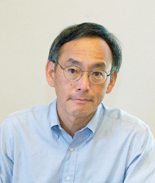 Lab
Director Steve Chu encourages Berkeley Lab employees to plan their
work carefully and avoid injuries. “Over the past few months
our safety performance has slipped. I am pained when I see my fellow
workers hurt on the job, especially when these injuries are, in many
cases, so easily preventable. To get back on the right track, slow
down and think through what you are doing to make sure you are working
as safely as possible. If you aren’t sure, use your co-workers
to help you check yourself. Peer checking is important in safety and
well as in science. If we work smart and help each other, we will
also work safely.” Photo by Roy Kaltschmidt, CSO
Lab
Director Steve Chu encourages Berkeley Lab employees to plan their
work carefully and avoid injuries. “Over the past few months
our safety performance has slipped. I am pained when I see my fellow
workers hurt on the job, especially when these injuries are, in many
cases, so easily preventable. To get back on the right track, slow
down and think through what you are doing to make sure you are working
as safely as possible. If you aren’t sure, use your co-workers
to help you check yourself. Peer checking is important in safety and
well as in science. If we work smart and help each other, we will
also work safely.” Photo by Roy Kaltschmidt, CSO
Repetitive stress injuries are also on the rise, which is a constant threat because Berkeley Lab employees spend a lot of time using computers. To prevent repetitive stress injuries caused by computer keyboard and monitor use (which may result in pain and numbness), the National Institute for Occupational Safety and Health recommends 15-minute task breaks for every two hours of moderate computer work, and 10-minute task breaks for every hour of intense computer work. Computer users should also look at a distant object for a few seconds every 5 to 10 minutes to relax eye muscles.
In addition, computer users should stop and stretch their back, neck, shoulders, arms, and legs at least twice a day. This involves getting up from the workstation and walking around, which improves circulation. Sitting for long periods of time can lead to muscle aches, so intersperse computer work with other tasks. Whenever possible, organize work to avoid long stretches of time at the computer. Make sure computer workstations are properly configured. If in doubt, request an ergonomic evaluation at www.lbl.gov/ehs/ergo/ workstation_eval.shtml.
Take care with electrical equipment
At Berkeley Lab, nine incidents in the past two years involved electrical shock. Only qualified electrical workers, as specified by our safety policies and procedures, should work on live electrical equipment above 50 volts or above 500 watts. At Berkeley Lab, only trained electricians, electronic technicians, and a few others designated by management are qualified to do energized electrical work. Fortunately, none of our nine injuries were serious — but they could have been. Similar circumstances at Stanford Linear Accel-erator Center led to a very serious injury and the employee is still away from work six months later.
Proper work practices can help avoid electrical incidents for non-qualified electrical workers. Several electrical injuries involved non-qualified employees touching internal components of live electrical equipment. If you need to repair an electrical device that is energized, or obtain a reading or measurement, get assistance from a qualified worker.
When using electrical equipment such as research apparatus, coffee pots, office heaters, and power equipment, take the time to read the manufacturer’s instructions and use the equipment properly. Researchers know their equipment best. They may have even designed it. But that doesn’t mean they are qualified to work on the equipment when it is energized. All electrical equipment rated above 50 volts or above 500 watts must be de-energized before it is worked on, or you must obtain an energized electrical permit. The Electrical Safety Subcommittee and EH&S are developing a training course to qualify researchers to work on some energized electrical equipment.
Richard Brown Sees Bright Future For Green Power
“This is a very exciting time to be in energy research, and Berkeley Lab, with all the science that is going on here, on the UC Berkeley campus and throughout the Bay Area, is a great place to do the work,” says Richard Brown, an energy analyst with Berkeley Lab’s Environmental Energy Technologies Division, who works in the Energy End-Use Fore-casting and Market Assessment Group. Since joining the Laboratory in 1991, Brown has been a key participant in such major energy-conservation efforts as the vaunted ENERGY STAR program from the Environmental Protection Agency and the creation of the Guide to Purchasing Green Power through DOE’s Federal Energy Management Program, EPA, the World Resources Institute, and the Center for Resource Solutions. In his work, he has had to straddle the sometimes wide divide between scientific research and marketplace realities to find solutions that are practical. Given that we, as a society, must now straddle the divide between our need for energy and our need for a healthy environment, he has unique insights to share with us during Earth Month 2005.
VIEW: How did you come to be involved with the ENERGY STAR program?
Richard Brown
BROWN: ENERGY STAR was started by the EPA in 1992 as a a voluntary labeling program designed to identify and promote energy-efficient products. It began out of concern for the growing power demands of computers and monitors. The computer industry loved it because it cost them very little to introduce sleep modes, and consumers liked the idea of saving energy. Because of the program’s initial success, EPA wanted to expand it to other office equipment as well as home appliances, but the agency needed technical help to understand how best to target their program. Basically, you need to be able to look at the energy use and characteristics of different products and determine which ones can save the most energy. Berkeley Lab, through the earlier work of people like Art Rosenfeld and Alan Meier, had a lot of experience in this area. Jonathon Koomey and I began working with the EPA in 1993. ENERGY STAR now labels over 40 different product categories for the home and office.
VIEW: How successful has the ENERGY STAR program been?BROWN: I believe that the ENERGY STAR program has had a significant effect on increasing the market share of efficient products. For many household appliances and consumer electronics other than computers, the share has grown to over 50 percent ENERGY STAR-compliant, and for personal computers, it is nearly 100 percent. Most importantly, the ENERGY STAR label is firmly embedded in the consciousness of consumers as the symbol for energy efficiency. Studies have shown that when other factors are pretty much equal, many consumers will buy the product that is more energy efficient, and the ENERGY STAR label helps influence that decision. The goal of the ENERGY STAR program, and the ultimate goal of our research here at the Energy End-Use Forecasting group, is to transform the market so that consumers, whether residential, office, or industrial, routinely purchase energy-efficient products. To achieve that goal, the motivation to change comes from a mixture of government intervention and market incentives.
VIEW: There seems to be some disagreement as to what exactly green power is. As a co-author of the Guide to Purchasing Green Power, can you clarify the concept?
BROWN: In the broadest sense, green power can be any environmentally benign source of energy, which would include electric and thermal. However, it has become a marketing term for electricity that is partially or entirely generated from renewable energy sources that minimize the environmental impact, such as solar, wind, geo-thermal, or biomass. There has been confusion over the concept, and one of the purposes that my colleague, Bill Golove, and I set out in creating the Guide to Purchasing Green Power was to help correct some of the misconceptions. One of the biggest ones is that the only benefit of using green power is for public relations. Our guide shows that using green power can be good for financial and other reasons.
VIEW: Is this another of your market transformation goals, like with the ENERGY STAR program?
BROWN: In a sense, yes. Originally, the idea of using green power was sold on the basis of helping to save the planet, but the renewable energy and energy-efficiency community over the years has realized that we need to appeal to enlightened self-interest: an organization should use green power because it helps them achieve their own goals and also helps save the planet. This seems to have been an effective approach, as we’re seeing an increased use of green power by many institutions, especially federal agencies such as the military. There are several U.S. Air Force bases that now get their electricity almost exclusively from green power.
VIEW: The energy news, at least here in California, is depressing. With prices at the gas pump soaring and gas and electric bills continually climbing, is there any reason to believe that energy conservation can really make a difference?
BROWN: Absolutely. The state of California has pursued an aggressive energy-conservation plan over the past three decades and, as a result, our per capita electricity consumption has remained relatively flat. Meanwhile, per capita electricity consumption in the rest of the United States has risen about 50 percent over this same period. Of course, the downside is that despite our efforts, we in California have only been able to offset the growth in the state’s population. We need to do a much better job of improving energy efficiency, while keeping in mind that greater energy efficiency does not by itself solve our environmental problems. In my view, what this means is that we need to pursue many different solutions, including renewable energy sources and reduced consumption of materials.
The work we’ve done to date is impressive, but it’s really just a prelude to the major changes needed to bring about a fundamentally different energy system. California is leading the charge on this effort, which is one of the big reasons that Berkeley Lab is a great place to pursue these topics.
A Voyage in the South Atlantic
Last year Jim Bishop of the Lab’s Earth Sciences Division (ESD) learned that NOAA’s Research Vessel Ronald H. Brown would make a January voyage through the South Atlantic, from the Antarctic to the equator, to measure increased ocean CO2 from human activity. Bishop wanted data to augment that from a voyage he and ESD’s Phoebe Lam had made in the North Atlantic — and, says Bishop, who modifies SOLO floats as Carbon Explorers, “It seemed a perfect opportunity to torture-test some new instruments.” Just one catch: nobody in his group could take the time.
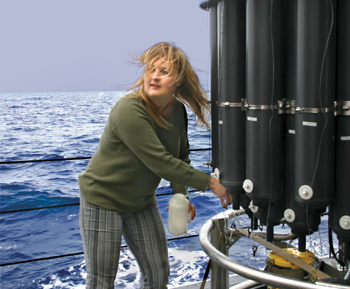 Alex Thompson retrieves samples of deep water from a collection bottle
on the RV Ron Brown.
Alex Thompson retrieves samples of deep water from a collection bottle
on the RV Ron Brown.
Alex Thompson is a New Zealander with a Ph.D. in atmospheric chemistry from Toronto’s York University; she came to UC Berkeley on a Miller Institute postdoctoral fellowship to work with soil scientist Ronald Amundson because, she says, “a major question in atmospheric chemistry is the relationship of the atmosphere and the biosphere.” Learning that Bishop needed a volunteer, Thompson signed on — and before long found herself in Punta Arenas, Chile.
Thompson is a sailboat enthusiast but had never been aboard a ship. Intent on teaching herself navigation, she followed with map and compass as the RV Ron Brown left Punta Arenas, halfway through the Straits of Magellan. Expecting a turn eastward toward the Atlantic, she was puzzled when her compass indicated they were heading nearly due south. It developed that an Atlantic storm had forced the captain to go around Tierra del Fuego, through the Beagle Channel. Soon the ship was passing “narrow fjords, blue glaciers coming down to the water, towering, incredibly abrupt cliffs … deep green foliage and rainbows.”
Farther south the waters teemed with seals, penguins and whales, the air with albatrosses and “tons of tiny seabirds, which kept up with the boat even though we were belting along at 12 knots.” Then came Iceberg Alley and days of horrific weather, and Thompson started working 20 hours a day.
The RV Ron Brown samples seawater by lowering a “rosette” of bottles overboard and collecting water at specific depths almost all the way to the sea bottom, typically some five kilometers deep. Mounted under the rosette were Bishop’s devices for measuring light scattering, POC (particle organic carbon), and PIC (particle inorganic carbon), which sent data up the wire to the ship.
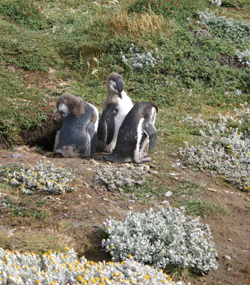 Magellan penguins take up permanent residence near Punta Arenas, Chile.
Magellan penguins take up permanent residence near Punta Arenas, Chile.
The PIC sensor, developed at Berkeley Lab, detects calcium carbonate from plankton shells by polarization. The night before Thompson flew to Chile, ESD’s Todd Wood stayed up all night making last-minute adjustments, rode BART to the airport, and handed the PIC sensor to her as she waited to board the plane.
At sea the ship reached a new station every eight hours, a half-degree farther north, then sent the rosette down for a new set of samples. In between, Thompson worked feverishly to filter the particles from her water samples for analysis back at Berkeley Lab, check the data transmitted by the instruments — and repair whatever had broken.
Throughout, she stayed in email touch with Bishop. Daily he worked up simulations of what her instruments should be reading, partly based on sea color in NASA satellite images indicating biomass. “Alex literally didn’t have time to sleep,” Bishop says. “One thing I wanted to do was let her know when there was blue water ahead” (indicating less productive waters) “so she could slow down.”
As the RV Ron Brown steamed into the biologically less active tropics, Thompson found herself growing bored; when the ship finally made port in Fortaleza, Brazil, she took a couple of weeks off to give herself a break — by promptly heading up the Amazon.
More about the voyage of the Ron Brown will appear soon online in Science@Berkeley Lab.
Environmental Fair Next Thursday
April 21, 11:30 am - 1:30 pm
In observance of Earth Month, Berkeley Lab will hold its annual Environmental Fair to inform employees about relevant issues and showcase the Lab’s efforts on environmental management and leadership.
The event will be held on April 21 on the lawn outside the cafeteria from 11:30 a.m. to 1:30 p.m. (or in the cafeteria lobby if it rains).
Lab divisions and employee organizations will have tables, as will selected outside organizations. Staffing them will be representatives from the Lab’s Waste Management group (in EH&S), Vegetation Management (Facilities), the Benefits Department, the DOE-Berkeley Site Office, the In-House Energy Management program, the Lab’s Bicycle Coalition, and the Outdoor Club. Ouside vendors will include Boise Cascade, a Toyota dealer (demonstrating the PRIUS hybrid car), Friends of Strawberry Creek, and Rebuilding Together. A local bike shop will offer free tune-ups.
A special lunch will be provided outside by Eurest Café, which will also hold a sale on its items and offer giveaways.
Downtown Laboratory employees are being encouraged to attend, with a special raffle for lunches at downtown restaurants to be held exclusively for downtown employees.
External efforts
In addition to the Environmental Fair, Berkeley Lab is participating in two important community programs and events that highlight energy efficiency and environmentally-friendly policies:
Rebuilding Together: Berkeley Lab will contribute materials and volunteer teams to this project to retrofit low-income family and senior homes with energy and water-saving devices. Contact Allan Chen at X4210 to help.
Energy Symposium and Green Home Expo (April 30): The Lab is a co-sponsor of the event, along with the City of Berkeley and other organizations. Jim Lutz of the Environmental Energy Techologies Division will speak at the event.
ASD to Be Reintegrated with Science Programs
After almost 10 years of providing support services to scientific and operations programs from a central hub, the Administrative Services Division (ASD) will reorganize into a decentralized system of department and division-based management, effective this month.
Director Steve Chu said the change does not suggest any shortcomings of the ASD system but rather a necessary adjustment based upon strategic plans, budget realities, and the nature of Laboratory administration in 2005.
“The Laboratory is a different place, with a breadth of interdisciplinary programs and new initiatives,” he said. “We want to make the scientific divisions more accountable for their operations, so it will be important to integrate the support programs back into the scientific programs.”
David McGraw, Associate Labora-tory Director for Operations, complimented ASD Head Anil More and his team for ASD’s considerable successes. “I’ve been impressed with the discipline that the ASD program has brought us,” he said, “and the focus it has placed on the performance and development of the people in ASD. The ASD Academy has been a success story, and we plan to continue and even expand class offerings through its operation.”
Of special note, he said, were the efforts that led to defining proper job classifications and the use of market-based salary surveys to validate compensation levels. This position leveling made the new reintegration possible, McGraw added.
He especially cited the work of More and his deputy, Karen Ramorino, for their oversight of
the program, and of Meredith Montgomery, ASD’s first official head in 1998. McGraw also noted the important contributions of the business managers, to whom he is looking “to ensure the quality continuity of administrative services in the divisions.”
The organizational changes mean that of the nearly 300 employees who are currently in ASD, the exempt (nonrepresented) employees will now be managed by their relevant division or department heads. The shift of the non-exempt ASD staff will take place following the appropriate notification and discussions with relevant union representatives.
Reporting relationships will remain largely unchanged, according to McGraw, with the exception of business managers. Travel and conference services, also a part of ASD, will eventually be transferred to the Office of the Chief Financial Officer (CFO).
The Administrative Services Department was established by former Director Charles Shank in December 1995 with the goal of “providing administrative services in a seamless manner.” It was set up in Operations as a model for flexibility and fairness, focusing on shared resources whenever possible that would cut costs and maximize benefit. It was also designed to improve opportunities for staff to develop skills and advance their careers, which McGraw said was one of the program’s biggest assets.
“I think ASD did a wonderful job of helping its employees broaden their opportunities and, when possible, move up within the system,” he said. “The ASD Academy was an integral part of that development program and will continue to be so. I’d like to expand its offerings to include more management and leadership training, too.”
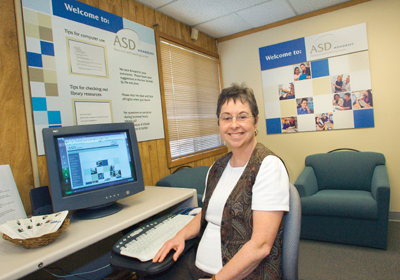 The ASD Academy has flourished under Sue Bowen's management.
The ASD Academy has flourished under Sue Bowen's management.
He cited Academy manager Sue Bowen for her leadership in getting the center to its present stage.
In the end, McGraw said, senior management listened to its customers, the divisions, to determine the best approach for providing administrative support for scientific programs. Today’s research environment of multiple funding sources, interdisciplinary projects, shifting priorities and uncertain budgets requires resource assessments at the divisional level.
“The concept of sharing resources to reduce costs is critical, and ASD established a culture of efficiency that I hope continues,” said McGraw.
He added that More and Ramorino will be reassigned to other high-priority challenges within the Lab.
Classroom’s Loss is Lab’s Gain: Aundra Richards Heads BSO
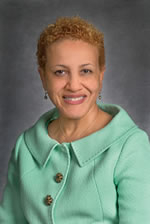 Aundra Richards
Aundra Richards
When Aundra Richards emerged from Santa Clara University with her master’s degree in history, she had set her sights on a career in teaching. Then came her conversation with an aunt, who was a contracting officer for the U.S. Depart-ment of Energy. As a result, Richards applied for and received an internship with the DOE in Oakland.
Thus began a 25-year career of distinguished government service that is culminating in one of the most coveted of jobs: that of Manager of the Berkeley Site Office (BSO) for the DOE.
Aundra Richards succeeds Dick Nolan, who retired in January after 10 years in the position.
This is an exciting time to be at Berkeley Lab, Richards says, calling it “a unique and special place. As a history student in college, I read about the Lab and developed great appreciation for the pioneering work that has occurred here.” In particular, Richards points to the legendary leadership of Ernest O. Lawrence and his seminal vision of “team science.”
Ironically, Berkeley Lab’s historic legacy is also one of its biggest challenges — the aging condition of many Laboratory facilities. This is one of several key issues in which Richards will play a major role to help resolve.
“The lack of adequate onsite space, along with the aging buildings, challenge our ability to integrate operations and optimize scientific productivity,” she says. “The average age of facilities here is approaching four decades. Another related challenge is a constrained budget and the likelihood of flat budgets into the indefinite future.”
Nonetheless, Richards says she’s poised to take on this and other priorities, in close cooperation with Director Steve Chu and the rest of the Lab’s senior management team. Among those priorities, number one is safety. She shares the concern expressed by Chu and others about the rise in the number of recent injury accidents at the Lab.
“In my short time here, it’s clear that the Lab has a strong safety culture, and I’m confident that together we can re-establish our leading safety record,” she says.
Also on her first-year agenda is reorganizing the 23-person BSO for “OneSC,” the Office of Science initiative to implement a more “corporate” approach to DOE line management; administering a new Laboratory management contract expected to be announced this month; and overseeing project management for facilities like the Molecular Foundry (under construction), the Transmission Electron Achromatic Microscope (TEAM) upgrade at the National Center for Electron Microscopy, and the deconstruction of the Bevatron.
Richards says federal contracting is “in my bones,” having been a DOE contracting officer for over two decades. Following her internship in 1979, she was hired as a contract specialist in the procurement division, then worked her way up to director of contracts by the time the Oakland office closed in 2004. She comes to Berkeley from recent positions in the Office of Field Management and the National Nuclear Security Administration at DOE headquarters in Washington.
“I’m proud and excited to be here, and look forward to the challenges and opportunities that this position provides. I believe that the Lab’s success is truly DOE’s success.”
Berkeley Lab View
Published every two weeks by the Communications Department for the employees and retirees of Berkeley Lab.
Reid Edwards, Public Affairs Department head
Ron Kolb, Communications Department head
EDITOR
Monica Friedlander, 495-2248, msfriedlander@lbl.gov
STAFF WRITERS
Lyn Hunter, 486-4698
Dan Krotz, 486-4019
Paul Preuss, 486-6249
Lynn Yarris, 486-5375
CONTRIBUTING WRITERS
Jon Bashor, 486-5849
Allan Chen, 486-4210
David Gilbert, 925-296-5643
FLEA MARKET
486-5771, fleamarket@lbl.gov
Design
Caitlin Youngquist, 486-4020
Creative Services Office
Communications Department
MS 65, One Cyclotron Road, Berkeley CA 94720
(510) 486-5771
Fax: (510) 486-6641
Berkeley Lab is managed by the University of California for the U.S. Department of Energy.
Online Version
The full text and photographs of each edition of The View, as well as the Currents archive going back to 1994, are published online on the Berkeley Lab website under “Publications” in the A-Z Index. The site allows users to do searches of past articles.
Flea Market
- AUTOS & SUPPLIES
- ‘01 PRIUS, white, 62K mi, good cond, 1 owner, upgrading to ‘05 model, $15,500, Steve, X5396, 813-1426
- ‘00, TOYOTA CELICA, white, 57K mi, auto, orig owner, reg serv at dealer, new tires, $11,500, Duo, X6878, 527-7729
- ‘89 CELICA ST, manual, 95K mi, shows its age, needs a bit of work but fundamentally very sound, bo, Mark, X6581
- HOUSING
- BERKELEY, resid community of scientists/staff/grad students, Hearst Commons, 1146-1160 Hearst nr UC/pub trans/BART, res parking, internet, studio townhouses w/ decks, furn can be provided at no cost, hardwd flrs, skylights, dw, ac, intercom, sec, units from $850, 848-5371, http://www.live-work.us/cgi-bin/artbooks/berkeley.html
- BERKELEY HILLS, bay view, quiet, eleg & spacious furn suite, 1 bdrm/1 bth, liv rm, kitchenette, DSL, satellite TV/VCR, walk to UCB, by wk/mo or short stay, Pierre, 387-4015, pchew@ pacbell.net, www.bvsuite.com
- BERKELEY HILLS, fully furn rm w/ sep entry, full kitchen priv, w/d, quiet neighborhood, lovely backyard, next to bus stop, avail now, $795/mo, labartists@aol.com, 524-3851
- BERKELEY HILLS, bay view, lge sunny furn room, 17’x15’, priv ent, own bthrm, quiet neighborhood nr UC/pub trans/shops, cooking facil in adj rm, pool table, workout mach, w&d, $875/mo incl linens, dishes, utils, phone line, wireless DSL, dish satellite TV/VCR, no smok/pets, short stay, $325/wk, Carol, 524-6692
- BERKELEY HILLS, short-term lease, beautiful redwood house above campus, fully furn, 2 bdrm/2 bth, study and sunroom, avail July-Aug, dates & length of lease flex, $2,500 incl water & gardener, Phila, 848-9156, philajane@msn.com
- ELMWOOD, share eleg 11-rm house w/ 2 other non-smoking professionals, hardwd flrs, fp, sauna, music rm, guest rm, yellow Lab, backyard w/ fishpond & trees, lge bdrm & closet w/ washstand, weekly shared dinners, $925/mo + dep/shared util/other expenses, Tony, 841-4480
- NORTH BERKELEY, in-law studio, avail 4/15, sunny, quiet, priv studio in garden setting in lovely neighborhood, hardwd flrs, kitchen w/ gas stove, bthrm w/ tub, dressing rm, laundry facil, easy parking, $800 /mo, mo-to-mo, for 1 quiet person, no pets/smok, Ms. Wurth, 527-5505, nonet@xoma.com
- SOUTH BERKELEY, 1 bdrm apt, unfurn, 7 unit bldg, w/ character, quiet, 15 min walk to campus, near bus, shopping & park, util incl, avail 5/1, 1-yr lease, $925/mo, kkelley@ samplehead.com, Kathy, 326-7836, Guy, X4703
- WALNUT CREEK, 2 bdrm, fully furn for summer, 5/22 – 8/21, 1 bdrm is set up as a study/office w/DSL, nr Walnut Creek BART, 15 min walk, 5 min bike ride, $900/neg + util, quiet & safe, unit is part of duplex w/ 3 other duplexes set way off from resid street, secluded, Dennis, (925) 947-5925 home, (415) 385-8356 cell, DJLamenti@lbl.gov
- MISC ITEMS FOR SALE
- ENTERTAINMENT ARMOIRE, traditional style, solid wood (cherry), 40”Wx 23”Dx74”H, pictures avail, asking $450, Marilee, X4145
- FREE
- WOODEN COFFEE TABLE, Alex, X6849
- VACATION
- PARIS, FRANCE, nr Eiffel Tower, furn, eleg & sunny 2 bdrm/1bth apt, avail yr-round by wk/mo, close to stores/rest/pub trans, 848-1830
Flea Market Policy
Ads are accepted only from Berkeley Lab employees, retirees, and onsite DOE personnel. Only items of your own personal property may be offered for sale.
Submissions must include name, affiliation, extension, and home phone. Ads must be submitted in writing (e-mail: fleamarket@lbl.gov, fax: X6641), or mailed/delivered to Bldg. 65.
Ads run one issue only unless resubmitted, and are repeated only as space permits. Ads must be submitted in writing and be no more than 50 words in length. The submission deadline for the April 29 issue is Thursday, April 21.